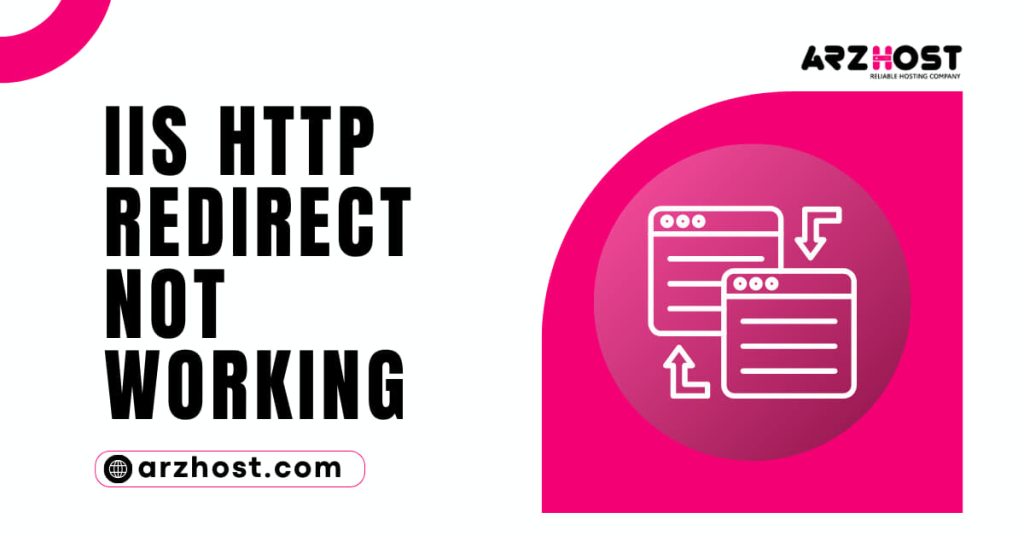URL redirection can be disappointing for site owners if the redirection isn’t functioning truly to form. “IIS HTTP Redirect Not Working – Mutual error and Solutions”, The URL change requires an appreciation of the rules before making it.
As a part of our Server Management Services, we assist our customers with sales to fix URL redirection. Today, “IIS HTTP Redirect Not Working – Mutual error and Solutions”, around here at ARZHOST, we should see the ordinary error when setting redirection from IIS and how our Hosting Expert Planners fix it.
How redirection is set from IIS?
Permit us to look at how our Hosting Expert Planners set redirection from IIS. “IIS HTTP Redirect Not Working – Mutual error and Solutions”, The redirection for a space is set from URL change in IIS.
Start >>Administrative Tools >> Internet Information Services (IIS) Manager >> Sites >> Domain name >> URL alter.
Select another norm and pick a reasonable rule in Inbound Rules. “IIS HTTP Redirect Not Working – Mutual error and Solutions”, Enter the standard ward on the need and apply the standard once wrapped up.
IIS redirect not working – Common errors
As of now, “IIS HTTP Redirect Not Working – Mutual error and Solutions”, we should see the typical errors during setting up redirection in IIS and how our Hosting Expert Developers settle them.
1) HTTP to HTTPS not working
One of the most broadly perceived bumble defies is HTTP to HTTPS not working. “IIS HTTP Redirect Not Working – Mutual error and Solutions”, Actually a customer contacted us referring to that the redirection isn’t working.
On separating, we saw that the HTTPS area was not in the restricting. HTTPS requests use secure port 443. Simply port 80 is accessible. To fix it our Techs added the HTTPS entry to confining:
2) Redirection type not set true to form
Another typical misstep is because the 301 redirection type isn’t set for the redirection. On causing a URL to redirect rule for space 301 redirection type should be set. “IIS HTTP Redirect Not Working – Mutual error and Solutions”, A 301 redirect is a durable divert with one URL then onto the following.
On such occasions, “IIS HTTP Redirect Not Working – Mutual error and Solutions”, our Planners check the nuances and change the redirection type:
3) Incorrect rules
Creating rules in IIS can be perplexing. A little oversight in the standard can make the redirection not work. Thusly, making the URL change administers ought to be right.
“IIS HTTP Redirect Not Working – Mutual error and Solutions”, Our Planners analyze the principles and right the rules to make the site redirect suitably.
Setting up an HTTP/HTTPS redirect in IIS
At the point when the SSL verification is presented, your site remains accessible through a standard temperamental HTTP affiliation. To relate securely, “IIS HTTP Redirect Not Working – Mutual error and Solutions”, visitors ought to demonstrate the https://prefix truly when entering your site’s area in their projects.
To force a strong relationship on your site, set up a particular HTTP/HTTPS redirection rule. Thusly, any person who enters your site using an association like “yourdomain.com” will be redirected to “https://yourdomain.com” or “https://www.yourdomain.com” (dependent upon your dynamic) the traffic mixed between the server and the client-side.
Coming up next are steps to plan an IIS HTTPS redirect:
- Download and present the URL Rewrite module.
- Open the IIS Manager console and select the site you should apply the redirection to in the left-side menu:
- Twofold tap on the URL Rewrite image.
- Snap Add Rule(s) in the right-side menu.
- Select Blank Rule in the Inbound region, then, press OK.
- Enter any standard name you wish.
- In the Match URL portion:
- Select Matches the Pattern in the Requested URL drop-down menu
- Select Regular Expressions in the Using drop-down menu
- Enter the going with the model in the Match URL portion: (. *)
- Check the Ignore case box
- In the Conditions portion, select Match all under the Logical Grouping drop-down menu and press Add.
- In the instigated window:
- Enter {HTTPS} as a condition input
- Select Matches the Pattern beginning from the drop menu
- Enter ^OFF$ for instance
- Press OK
- In the Action fragment, select Redirect as the action type and decide the going with for Redirect URL:
https://{HTTP_HOST} {REQUEST_URI}
- Un-check the Append request string box.
Select your favored Redirection Type. The whole Action region ought to look like this:
-
- Permanent (301): optimal sort for the present circumstance, which tells clients that the substance of the site is always moved to the HTTPS variation. Helpful for SEO, “IIS HTTP Redirect Not Working – Mutual error and Solutions”, as it conveys all the traffic to your HTTPS webpage making an advantageous result on its situating in web crawlers.
- Found (302): should be used given that you moved the substance of explicit pages to another spot *temporarily*. This way the SEO traffic goes for the post content’s space. This decision is generally not proposed for an HTTP/HTTPS redirect.
- See Other (303): express redirect type for getting requests. Not recommended for HTTP/HTTPS.
- Temporary (307): HTTP/1.1 substitution of 302 redirect type. Not recommended for HTTP/HTTPS.
- Specify the Redirect Rule as HTTPS://{HTTP_HOST}/{R:1} and check the Append request string box. The Action type is moreover to be set as Redirect. Snap-on Apply on the right 50% of the Actions menu
The IIS redirect can be checked by getting to your site through http://demonstrated in the URL. “IIS HTTP Redirect Not Working – Mutual error and Solutions”, To guarantee that your program shows not the put-away version of your site, you can use obscure strategy for the program.
The standard is made in IIS, yet the site is at this point not redirected to HTTPS://
Usually, the redirection rule gets formed into the web. config record arranged in the account root list of your webpage. “IIS HTTP Redirect Not Working – Mutual error and Solutions” If the redirection doesn’t work strangely, guarantee that web. config exists and checks if it contains the appropriate rule.
To do this, follow these methods:
- In the objections overview of IIS, right-click on your site. Pick the Explore decision:
- The research will open the record root list of the site. Check if the web. config report is there.
- The web.config archive ought to have the going with code block:
- <configuration>
- <system. Webserver>
- <rewrite>
- <rules>
- <rule name=”HTTPS power” enabled=”true” stop Processing=”true”>
- <match url=”(. *)”/>
- <conditions>
- <add input=”{HTTPS}” pattern=”^OFF$”/>
- </conditions>
- <action type=”Redirect” url=”https://{HTTP_HOST} {REQUEST_URI}” redirect Type=”Permanent”/>
- </rule>
- </rules>
- </rewrite>
- </system. Webserver>
- </configuration>
That the web. config record is missing, you can make a new .txt report, put the recently referenced code there, “IIS HTTP Redirect Not Working – Mutual error and Solutions”, save and a while later rename the archive to the web. config
Assumption
The error IIS redirect not working can be disappointing. Today, “IIS HTTP Redirect Not Working – Mutual error and Solutions”, at ARZHOST, we saw how our Hosting Expert Planners settle relatively few ordinary errors with redirection.
People Frequently Ask
Question # 1: How long does it take for a 301 redirect to work?
Answer: Google’s Webmaster Trends Analyst John Mueller said that 301 redirects applied to permanent site move situations should be active for a long time. He explained that it takes at least six months to roughly a year for Google to be able to completely recognize that your site was moved.
Question # 2: How do I configure HTTP to redirection in IIS?
Answer:
- Download and install the IIS URL Rewrite module, then launch IIS Manager.
- Select the website you want to apply redirection to, then double-click URL Rewrite.
- Click Add Rule
- Select Blank rule in the Inbound Rules section, then click the OK button.
- Give your redirect an easy-to-remember name.
Question # 3: What is the difference between URL rewrite and redirect?
Answer: Simply put, a redirect is a client-side request to have the web browser go to another URL. This means that the URL that you see in the browser will update to the new URL. A rewrite is a server-side rewrite of the URL before it’s fully processed by IIS.
Question # 4: How do I redirect a URL in HTML?
Answer: The simplest way to redirect to another URL is to use an HTML <meta> tag with the HTTP-Equiv parameter set to “refresh”. The content attribute sets the delay before the browser redirects the user to the new web page. To redirect immediately, set this parameter to “0” seconds for the content attribute.
Question # 5: What are HTTP redirects?
Answer: The HTTP redirect code, redirect for short, is a way to forward visitors and search engines from one URL to another. Redirects are used when moving content to a new URL, when deleting pages or when changing domain names or merging websites. Whenever possible avoid using redirects.









